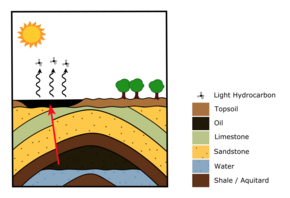Tar pit

Decayed organic matter is in the ground as well as soil and clay. Under pressure, the organic matter can change to oil. The crude oil seeps upward through fractures, or porous sedimentary rock layers. It may form a pool at the surface.[1]
The lighter parts of the crude oil evaporate into the atmosphere. That leaves behind behind a black, sticky asphalt.[1] Tar pits are often dug into because they contain many fossils.
There are not many tar pits in the world, because they only form in these circumstances. The lighter elements in the crude oil evaporate. This makes sticky tar. The sticky tar may trap animals. Their distress calls are irresistible to the predators which follow them.
List of tar pits[change | change source]
There are five natural asphalt lakes in Kern County, California. The La Brea Tar Pits are a registered National Natural Landmark. The Salt Lake and South Salt Lake oil fields are connected to La Brea. They are about 20/30 miles away to the northwest.
- La Brea: In the La Brea Tar Pits more than one million bones have been taken from the dried oil since 1906. 231 vertebrate species, 234 invertebrate species, and 159 plant species have been identified.[2] The most frequent large mammal found in the La Brea Tar Pits is the dire wolf. This is one of the most famous prehistoric carnivores that lived in the Pleistocene epoch.[3] Fossils from saber-toothed cats and coyotes are also common. More fossils are being discovered by excavation projects.
- For thousands of years, Native Americans used tar from the La Brea Tar Pits.[1] They used the tar as waterproofing to line their boats and baskets. When Westerners arrived at the tar pits, they began mining. They used the tar for roofing material in nearby towns.[1]
- Carpinteria tar pits, East of Santa Barbara, California. In an excavation, 25 plant species were found, 55 species of birds and 26 species of mammals.[4]
- Pitch Lake, Trinidad and Tobago. This is the largest deposit of solid bitumen on Earth. The top can be walked on, but underneath the asphalt bubbles away. The lake gets gradually softer and hotter near the center where the bitumen begins to bubble. The gas being released in the middle of the lake is largely methane with lots of carbon dioxide.[5]
- Binagadi Asphalt Lake in Azerbaijan, or in the Caucasus, a region between the Black Sea and the Caspian Sea.
- The general term which covers all kinds of oil reserves on Earth is "oil shale" or "oil shale reserves".
References[change | change source]
- ↑ 1.0 1.1 1.2 1.3 "La Brea Tar Pits". ucmp.berkeley.edu. Retrieved 2021-04-26.
- ↑ Kim, Jong-Shik; Crowley, David E. (2007-07-15). "Microbial diversity in natural asphalts of the Rancho La Brea Tar Pits". Applied and Environmental Microbiology. 73 (14): 4579–4591. Bibcode:2007ApEnM..73.4579K. doi:10.1128/AEM.01372-06. ISSN 0099-2240. PMC 1932828. PMID 17416692.
- ↑ "Dire Wolf". igws.indiana.edu. Retrieved 2021-04-26.
- ↑ Griggs, David (2014). "NEWSLETTER of the Carpinteria Valley Historical Society" (PDF). The Grapevine.
- ↑ Centre, UNESCO World Heritage. "La Brea Pitch Lake". UNESCO World Heritage Centre. Retrieved 2021-04-26.
